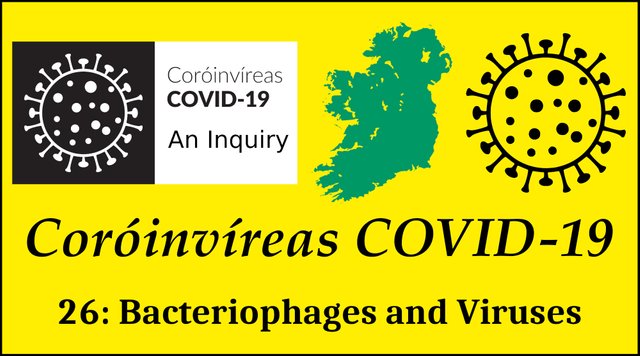
The dissident German scientist Stefan Lanka began his journey from virologist to ex-virologist when he discovered that bacteriophages and giant viruses do indeed exist and can be isolated in the correct sense of the word—but they are not pathogenic. In Lanka’s opinion, the pathogenic viruses that are said to cause a variety of diseases in humans and other animals have never been properly isolated and have never even been shown to exist.
During his studies, Stefan isolated bacteriophages from the sea. However, unlike most researchers, who simply parrot previous hypotheses, he subsequently reached different conclusions than the virologists. Stefan noted that the term phage was incorrect. These particles were not preying on bacteria in a parasitic way. The particles were spore-like in nature, which formed when the bacterial cells were in particular environmental conditions. They were not pathogenic, and therefore not viral, as is widely claimed. (Samantha & Mark Bailey)
In 2020, while the so-called COVID-19 Pandemic was in full swing, Lanka wrote a series of papers under the title The Virus Misconception. In Part 1, he described what he discovered about these bacteriophages:
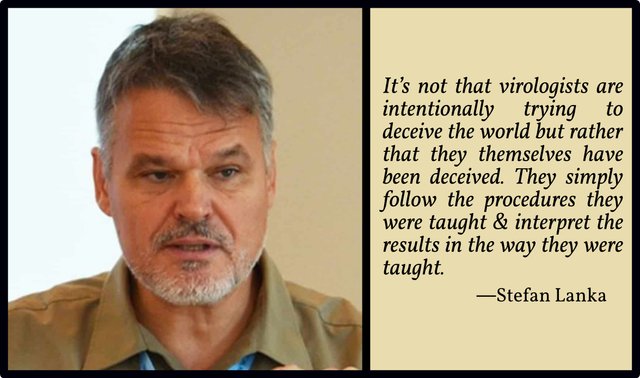
The source for the idea of a genetic virus in humans, animals and plants, which started to develop from 1953 onwards, were the so-called bacteria-eaters, called (bacterio)phages, which had drawn the attention of scientists since 1915. From 1938 on, when commercially available electron microscopes were applied in research, these phages could be photographed, isolated as whole particles and all their components could be biochemically determined and characterised. This is real, and cannot be contested. To isolate them, i.e. concentrate the particles and separate them from all other components (=isolation), to photograph them immediately in the isolated state and to biochemically characterise them all in one go—this, however, has never happened with the alleged viruses of humans, animals and plants because these do not exist.
The scientists researching bacteria and phages, who worked with actual existing structures, provided a model as to what human, animal and plant viruses could look like. However, the “phage experts” have overlooked by their misinterpretation of phages as bacteria eaters that the phenomenon of the formation of these particles is caused by the extreme inbreeding of bacteria. This effect, i.e. the formation and release of phages (bacteria eaters, aka bacteria viruses), doesn’t happen amongst pure bacteria, freshly extracted from an organism or the environment. When their nutrients are withdrawn slowly or their living conditions become impossible, normal bacteria—that is: bacteria which are not grown in the lab—create the known survival forms, the spores, which can survive for a long time or even “eternally”. From spores, new bacteria appear as soon as the living conditions improve. (Lanka 6)

Discovery
According to the orthodox teaching, bacteriophages are just a particular type of virus:
Bacteriophages are viruses that infect bacteria ... bacteriophages carry a genome (DNA or RNA) enabling them to reproduce in the cells they infect ... Bacteriophages (phages) are viruses that grow in bacterial cells utilizing their biosynthetic systems for reproduction. (Topley & Wilson 185 ... 188)
Bacteriophages were discovered over a century ago. In 1896 Ernest Hanbury Hankin, an English bacteriologist working in India, observed that water from the Ganges and Jumna rivers had antibacterial properties, allowing it to kill the strain of bacteria believed to cause cholera (Vibrio cholerae). When the water was passed through a fine porcelain filter it retained these antibacterial properties, but when it was boiled it lost them (Hankin 515).
Hanbury failed to isolate the antiseptic substance. All he was prepared to say about it was that it was volatile, since boiling destroyed it (Hanbury 520). He did not suspect that it was a microbe or organism. In the paper he submitted to the Pasteur Institute he simply refers to it as la substance antiseptique (the antiseptic substance).
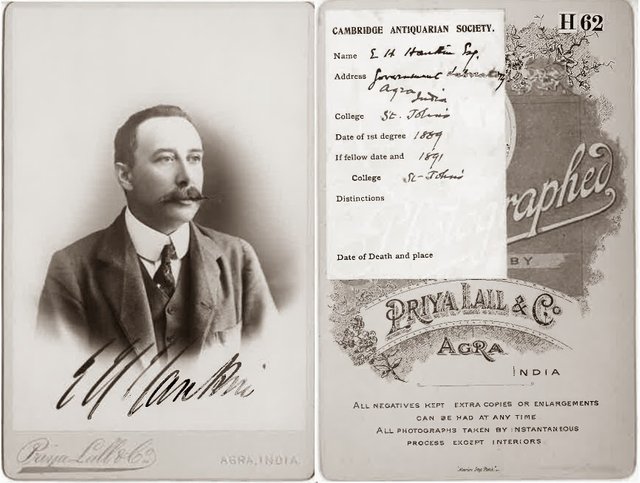
Frederick William Twort
Almost twenty years passed before another English bacteriologist, Frederick William Twort, identified bacteriophages for the first time. Twort had been searching for non-pathogenic viruses. He had reasoned that just as nature was replete with non-pathogenic forms of bacteria, so it was probably also the case that for every pathogenic virus there were several non-pathogenic varieties. The problem was that viruses were (and still are) identified and isolated by their pathogenicity—the cytopathic effect, which we looked at in an earlier article. How does one discover and isolate a virus that by its very nature does not produce a cytopathic effect? On the other hand, Twort reasoned that it ought to be easier to culture a non-pathogenic virus, since it does not kill the tissue in which it is being cultured.
... accordingly, attempts to cultivate these from such materials as soil, dung, grass, hay, straw, and water from ponds were made on specially prepared media. Several hundred media were tested. It is impossible to describe all these in detail, but generally agar, egg, or serum was used as a basis, and to these varying quantities of certain chemicals or extracts of fungi, seeds, &c., were added. The material to be tested for viruses was covered with water and incubated at 30°C or over for varying periods of time, then passed through a Berkefeld filter, and the filtrate inoculated on the different media. In these experiments a few ordinary bacteria, especially sporing types, were often found to pass through the filter; but in no case was it possible to obtain a growth of a true filter-passing virus. (Twort 1241)

In the course of his experiments, Twort discovered that something was killing the bacterial colonies of Micrococcus that survived the filtration process:
Experiments were also conducted with vaccinia and with distemper of dogs, but in neither of these diseases was it found possible to isolate a bacterium that would reproduce the disease in animals. Some interesting results, however, were obtained with cultivations from glycerinated calf vaccinia. Inoculated agar tubes, after 24 hours at 37°C, often showed watery-looking areas, and in cultures that grew micrococci it was found that some of these colonies could not be subcultured, but if kept they became glassy and transparent. (Twort 1242)
Whatever was killing the bacteria retained its bactericidal powers up to a temperature of 52°C, but when heated to 60°C for an hour it was destroyed. It also had some antibacterial properties when applied to Staphylococcus, but was ineffective against other strains of bacteria (Twort 1242). It was also harmless to non-bacterial cells:
The transparent material was inoculated into various animals and was rubbed into the scratched skin of guinea-pigs, rabbits, a calf, a monkey, and a man; but all the results were negative. (Twort 1242)
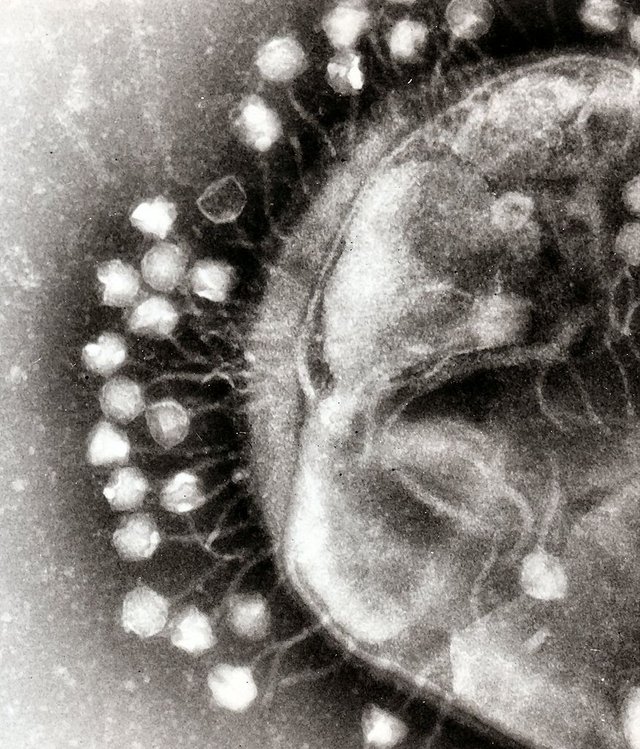
Like Hanbury before him, Twort was unsure what sort of substance he was dealing with. Unlike Hanbury, he suspected that it was a microbe, but he was also open to other possibilities:
From these results it is difficult to draw definite conclusions. In the first place, we do not know for certain the nature of an ultra-microscopic virus. It may be a minute bacterium that will only grow on living material, or it may be a tiny amœba which, like ordinary amœbæ, thrives on living microorganisms. On the other hand, it must be remembered that if the living organic world has been slowly built up in accordance with the theories of evolution, then an amœba and a bacterium must be recognised as highly developed organisms in comparison with much more primitive forms which once existed, and probably still exist at the present day. It is quite possible that an ultra-microscopic virus belongs somewhere in this vast field of life more lowly organised than the bacterium or amœba. It may be living protoplasm that forms no definite individuals, or an enzyme with power of growth.
In the vaccinia experiments described above it is clear that the transparent material contains an enzyme, and it is destroyed at 60°C. It also increases in quantity when placed on an agar tube containing micrococci obtained from vaccinia, and this can be carried on indefinitely from generation to generation. If it is part of the micrococcus it must be either a stage in its life-history which will not grow on ordinary media but stimulates fresh cultures of the micrococcus to pass into the same stage, or an enzyme secreted by the micrococcus which leads to its own destruction and the production of more enzyme. The fact that the transparent portion cannot be grown except on the micrococcus makes it impossible to obtain any definite evidence on these points. (Twort 1242)
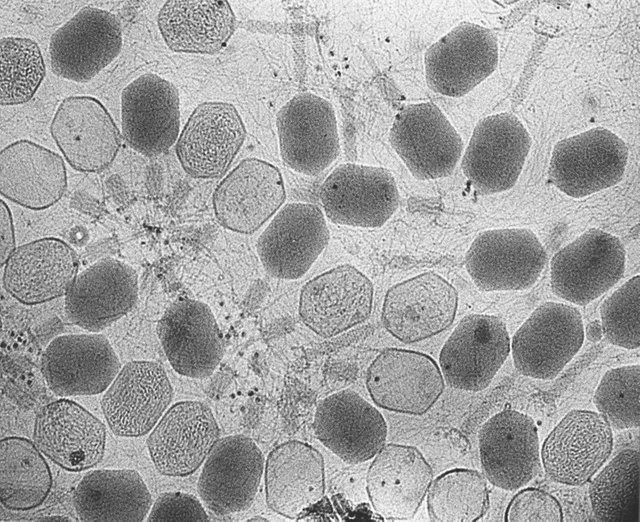
One important observation led him to suspect that the bactericide was not a separate organism but something produced by the bacteria themselves:
There is this, however, against the idea of a separate form of life: if the white micrococcus is repeatedly plated out and a pure culture obtained, this may give a good white growth for months when subcultured at intervals on fresh tubes; eventually, however, most pure strains show a transparent spot, and from this the transparent material can be obtained once again. Of course, it may be that the micrococcus was never quite free from the transparent portion, or this may have passed through the cotton-wool plug and contaminated the micrococcus. but it seems much more probable that the material was produced by the micrococcus. (Twort 1242)
This is precisely what Stefan Lanka hypothesizes, but modern bacteriologists have ignored Twort’s observation of this apparent spontaneous production of a self-destroying material, and insist that bacteriophages are independent organisms that prey upon bacteria.
Twort drew the tentative conclusion:
On the whole it seems probable, though by no means certain, that the active transparent material is produced by the micrococcus, and since it leads to its own destruction and can be transmitted to fresh healthy cultures, it might almost be considered as an acute infectious disease of micrococci. (Twort 1243)
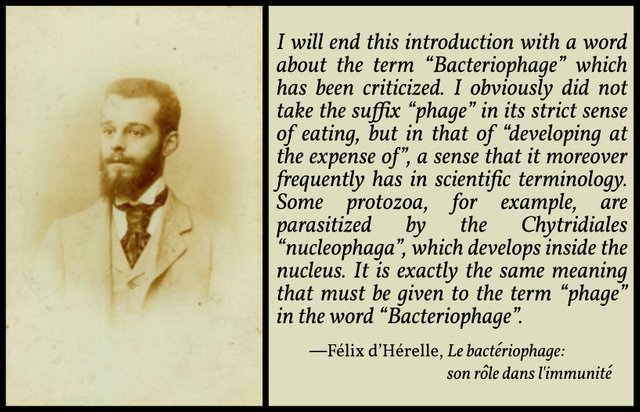
Félix d’Hérelle
At the time of publication, Twort’s discoveries were largely overlooked by the microbiological community, and it fell to the French microbiologist Félix d’Hérelle to independently rediscover bacteriophages in 1917.
Félix d’Hérelle was a French-Canadian microbiologist. He was born Hubert Augustin Félix Haerens in Paris in 1873 but settled in Canada at the age of twenty-four with his wife and daughter. There he built himself a laboratory and taught himself microbiology. Following in the footsteps of Louis Pasteur, he initially devoted himself to the study of fermentation (zymology), and earned a commission from the Canadian government in this field. He was later employed by the governments of Guatemala and Mexico, which allowed him to continue his researches in his chosen fields of bacteriology and zymology. In 1911 he returned to France, where he worked as an unpaid assistant at the Pasteur Institute in Paris.
Within a year he was on the road again—this time to Argentina, where he attempted to control plagues of locusts by infecting the insects with pathogenic strains of bacteria, known as coccobacilli on account of their shape. In Argentina d’Hérelle observed clear spots on some of his bacterial cultures where the bacteria did not grow, but he postponed further study of this phenomenon until his return to France.
During the two years of his employment by the Argentine government, d’Hérelle continued to return to the Pasteur Institute every 6 months. There he made the discovery that though rabbits are naturally immune to certain pathogens—such as the coccobacillus he was using to kill locusts, or the cholera microbe Vibrio cholerae—nevertheless they die if they are directly injected with these pathogens.
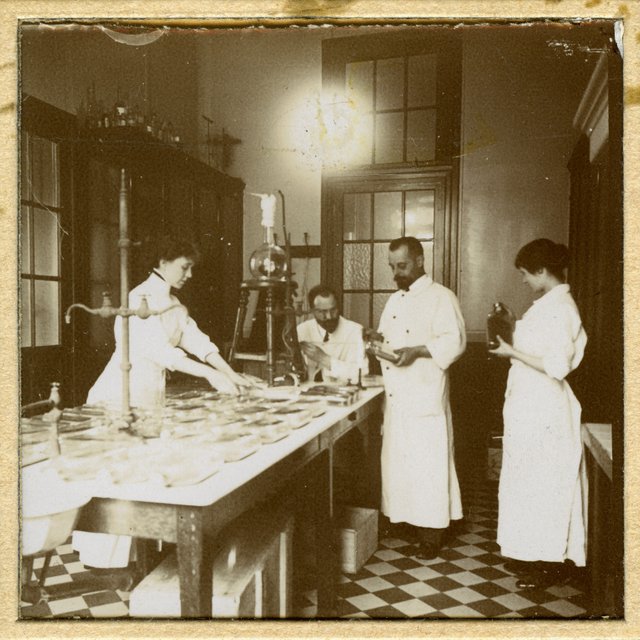
During the First World War, d’Hérelle worked for the French government, producing vaccines and other medications for the military. In 1915 he was tasked with studying an epidemic of dysentery which was then raging in a squadron of dragoons. Using the stools of his patients, he recreated an experiment he had carried out on locusts:
He passed an emulsion of dysenteric stool samples in a nutrient medium through a fine porcelain filter. This filtered out the dysenteric bacilli—Shigella dysenteriae, the pathogenic strain of bacteria believed to be the cause of the dysentery.
Then he mixed the filtrate with a laboratory-grown culture of dysenteric bacilli and allowed it to incubate for a few hours at body temperature of 37°C.
Next he spread some of this material on an agar plate—a Petri dish that contains a growth medium solidified with agar, and which is commonly used to culture microorganisms.
He also fed a few drops of the mixture to some laboratory rabbits. The rabbits remained healthy.
Twice d’Hérelle observed blank spots on the agar plates. Without fully understanding the phenomenon, he succeeded from time to time in reproducing them. Finally, in September 1915, he realized that it was always the filtrate of the last stool passed by the patient before recovery that produced the blank spots.
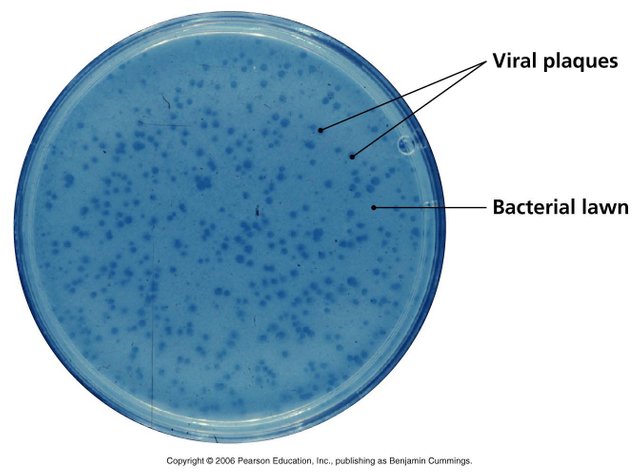
Hitherto he had surmised that these spots were somehow caused by—or, perhaps, the cause of—the disease. Now, however, he realized that they may represent a cure. He then decided to repeat the experiment daily with the stools of a hospitalized patient suffering from dysentery. Every day he would inoculate a very cloudy culture of dysenteric bacilli with the patient’s filtrate, leaving a control sample uninoculated. On the fourth day he made a startling discovery: while the control culture was still as cloudy as the day before—indicating that the bacteria were still growing—the cloudy culture from the day before was now perfectly clear. The dysenteric bacteria had all been killed.
In a flash, as d’Hérelle would later recount, he realized that he had discovered a virus that could destroy pathogenic bacteria and cure the disease they caused. He ran to the hospital to check on the patient whose stool sample had provided the crucial breakthrough and discovered that he had recovered. His findings were announced to the scientific community by Émile Roux, Director of the Pasteur Institute, at a sitting of the French Academy of Sciences on 3 September 1917.
From the stools of various subjects recovering from bacillary dysentery, and in one case from the urine, I isolated an invisible microbe endowed with antagonistic properties against the Shiga bacillus ...
The various strains of the “anti-” microbe that I isolated were initially active only against the Shiga bacillus ...
In the absence of dysenteric bacilli, the “anti-” microbe cannot be cultured in any medium. It does not attack heat-killed dysenteric bacilli. In contrast, it can be perfectly cultured using a saline emulsion of washed bacilli. This indicates that the anti-dysenteric microbe is an obligate bacteriophage. The anti-Shiga microbe exerts no pathogenic effects upon laboratory animals. Shiga cultures lysed under the effect of the invisible microbe, which, in reality, are cultures of the “anti-” microbe, are endowed with the capacity to immunize rabbits against a dose of Shiga bacilli, which would kill controls in 5 days.
The anti-Shiga microbe has no pathogenic action on experimental animals. The cultures lysed of Shiga under the action of the invisible microbe, which are in reality cultures of the “anti-” microbe, enjoy the property of immunizing the rabbit against a dose of Shiga bacilli that killed the controls in five days ...
This microbe, which is a veritable “microbe of immunity”, is an obligate bacteriophage. Its parasitism is strictly specific, but although it is limited to one species at a given time, it may in turn have an effect upon diverse germs via acclimatization. (d’Hérelle 373-375)
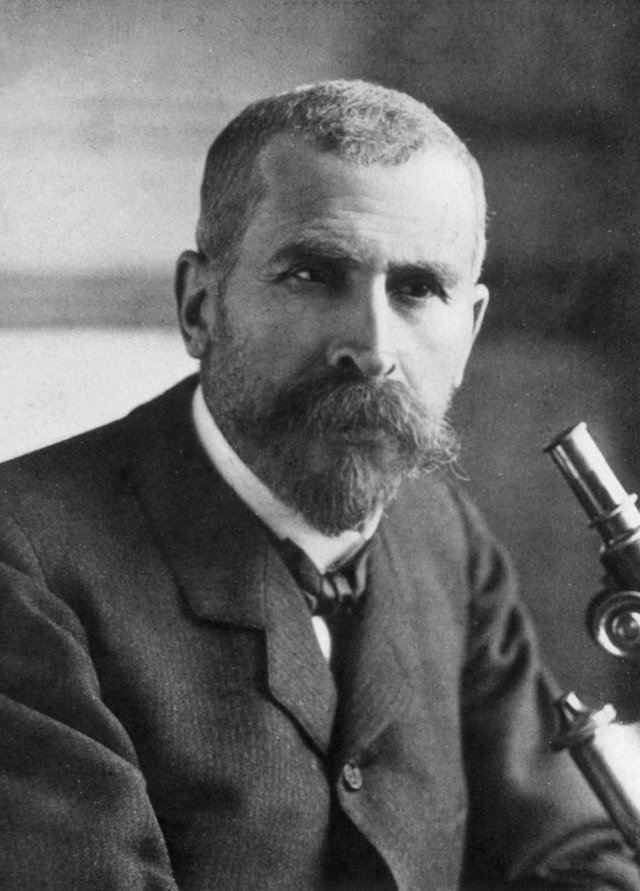
Bacteriophages
According to the orthodox view, bacteriophages are viruses that prey on specific strains of bacteria:
Phages are extremely common in the environment and can be found wherever their host bacteria are present. They are readily detected for most bacterial species. It is probable that all bacteria are sensitive to one or more phages which thus prey on their specific host strain or strains; it is rare to find one that infects a large number of species. (Topley & Wilson 188)
Bacteriophages are so ubiquitous that there are more of them than of all other organisms—including bacteria—combined.
Phage morphology is remarkably similar to that of viruses:
As an overall group of viruses, phages show considerable morphological diversity ... Some are filamentous, isometric and superficially resemble animal viruses, whereas other show complex morphologies. The capsid or the phage head is the structure containing the genome; this can be single or double stranded DNA or RNA. Some phages are virulent, killing each cell they infect, whereas others are temperate. In the latter case the phage resides, as a prophage, in a cell termed a lysogen and replicates synchronously with the cell. When phage replication is completed the particles are released from the cell. (Topley & Wilson 188)
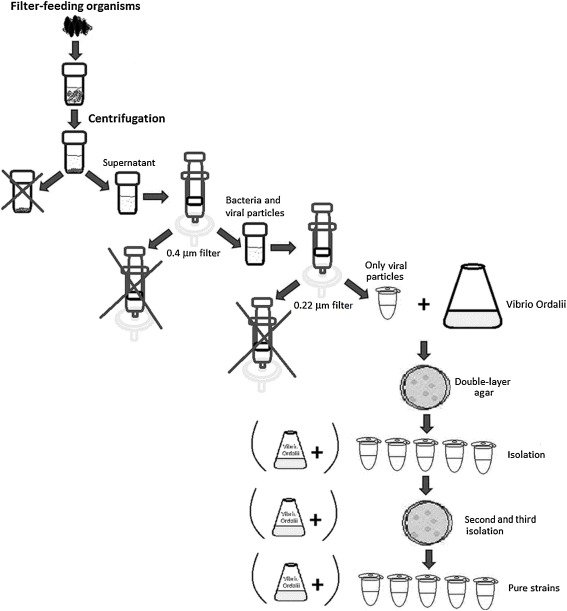
One significant difference between bacteriophages and ordinary viruses is the method of isolation. As we saw in an earlier article, viruses are “isolated” by culturing them in host tissues and observing the cytopathic effect the produce. For some reason, these organisms cannot be isolated directly by taking bodily fluids from infected patients, separating the components of the fluid by centrifugation, and passing the supernatant through very fine filters. But this is precisely how bacteriophages are isolated:
The isolation of bacteriophages for phage therapy is often presented as a fairly straightforward exercise of mixing a phage-containing sample with host bacteria, followed by a simple removal of bacterial debris by filtration and/or centrifugation the next day. (Hyman 1)
Numerous articles can be found online describe various methods of isolating bacteriophages. Despite the differences, they all describe the direct isolation of the phages from bacterial plaques by such methods as filtration and centrifugation. There is never any mention of the cytopathic effect:
How do you isolate a bacteriophage (phage) and obtain a pure phage preparation? This is achieved by plating a phage suspension using the double agar method, and a susceptible host strain, to obtain plaques and further purifying the phage contained within the plaque ...
... a small volume of a dilution of phage suspension and host cells are mixed in molten, ‛soft’ agar. The resulting suspension is then poured on to an appropriate ‛nutrient’ basal agar medium to form a thin ‛top layer’ which hardens and immobilises the bacteria.
During incubation the uninfected bacteria multiply to form a confluent lawn of bacterial growth over the surface of the plate. Each infected bacterium bursts after a short time and liberates progeny phages that infect adjacent bacteria, which in turn are lysed. This ‛chain’ reaction spreads in a circular motion until brought to a halt by a decline in bacterial metabolism. Plaques are zones of bacterial lysis caused by phage action and appear as circular zones of lysis on lawns of bacterial cells ...
Phages are purified by removing, picking off, a well isolated plaque using either a Pasteur pipette or more crudely, but just as effectively, a wire loop. Using a sterile Pasteur pipette the area around the plaque is stabbed and pieces of soft area are ‛sucked’ into the pipette ... the plaque material is added to 9 ml of 25% Ringers solution or other diluent ...
The phage suspension is then filter-sterilised through a 0.45 µm syringe-mounted, filtration unit ... to remove any bacteria including phage-resistant host bacteria. (Mullan)
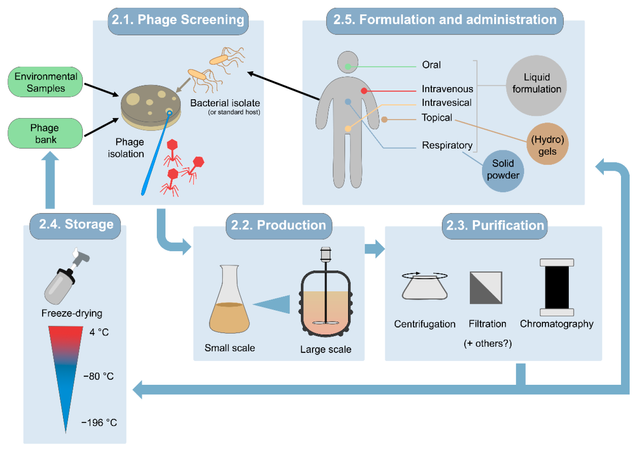
Questions
If bacteriophages are essentially viruses, with similar morphologies and physiologies to other viruses, why is the science and study of phages so different from the science and study of viruses?
Why can bacteriophages be isolated directly by culturing, centrifugation, and filtration, while all other viruses must be “isolated” by a complicated procedure involving exotic tissue culturing and the observation of the cytopathic effect?
Why can viruses evolve and change rapidly, allowing them to infect new host species and become immune to vaccines and antibodies, while bacteriophages can only infect specific strains of bacteria?
In 1915 Frederick Twort observed: On the whole it seems probable, though by no means certain, that the active transparent material is produced by the micrococcus, and ... leads to its own destruction. Why has this important observation been consistently ignored by modern microbiologists?
In 1917 d’Hérelle made the discovery that though the rabbits in his laboratory were naturally immune to certain pathogens—such as the coccobacillus he was using to kill locusts, or the cholera microbe Vibrio cholerae—nevertheless these same rabbits died if they were directly injected with the pathogen. Does this mean that the rabbits were not being killed by the so-called pathogen but by the unnatural treatment they were subjected to in the laboratory?

Hidden History
Bacteriophages have been successfully isolated and identified by adopting the obvious methods of filtration, centrifugation and electron microscopy : but these methods have never been successfully used to isolate and identify pathogenic viruses. The importance of this fact cannot be overstated. This extraordinary state of affairs obtains in spite of the fact that bacteriophages are essentially viruses, similar in size and structure to the alleged pathogenic viruses. The latter, however, can only be “isolated” and identified by culturing them in the laboratory using specialized and exotic tissue cultures. Why is this? What is it about pathogenic viruses that makes them impervious to procedures that work perfectly well in the case of their close cousins the bacteriophages? Could it be that these methods do not work because the pathogenic viruses do not exist in the first place?
According to another dissident scientist, Tom Cowan, virologists did indeed attempt to isolate viruses by direct methods in the 1930s and ’40s:
Take samples of mucous, lung fluid, pus, etc from a sick person or animal.
Put it in a centrifuge to separate out the constituents according to their masses. The tiny viruses will float to the top with the supernatant, while larger bodies will form a precipitate beneath the supernatant.
Pass the supernatant through fine filters to remove larger particles, isolating the smaller viral particles.
Infect a test subject with this isolate and see if they become ill.
But whenever they tried to infect animals with the isolated virus, they animals did not become sick. Therefore the virologists changed tack and devised an indirect method of isolating viruses: the tissue-culturing method with its cytopathic effect. Cowan discusses this in an interview with health consultant Ben Greenfield:

Ben: ... what a virologist would do if they did want to like isolate and characterize and demonstrate the existence of a virus or a new thing like SARS-CoV-2, they would take a bunch of samples from infected people like blood, or sputum, or I don’t know what else you might collect. Some type of bodily secretion from people who are demonstrating symptoms of what we suspect might be a virus, and those symptoms are unique and specific enough to where we can say, okay, all these people are showing signs of something that shows that they have something that we suspect might be something. And then, basically, what they then do is they take those samples, and ideally, they would not mix them with anything else that has any other genetic material, and then they would do what they do in the lab, filter it and macerate it and centrifuge it and purify this specimen. And, that would be a common virology technique that I understand the virologists have done for quite some time to isolate bacteriophages and so-called viruses. And, if they did that, that would allow them to demonstrate with then typically an electron microscopy tool, a whole bunch of different particles that they would then be able to say are the isolated and purified virus. Then, they could go and check those with microscopic techniques to determine the purity and to further characterize the particle examining the structure, or the chemical composition, or what we call the morphology. And then, you’d have to extract the genetic material from ... these purified particles. And then, that would be done using a genetic sequencing technique. That’s old technology, it’s been around for decades. And then, you would analyze whether those particles are outside the cell, what we call exogenous. Meaning that they were something that originated from somewhere outside the human body. And, they weren't the normal breakdown products of dead or dying tissue in the body.
And, if you’ve done all of that, you would have fully isolated and characterize and genetically sequence this particle that you would then want to call a virus. And then, if you successfully did that, you’d then have to go out and show that it’s actually causally related to a disease, so you’d have to expose a bunch of healthy subjects. Preferably these days, they would be cute little animals and you’d expose them to this isolated purified thing that you suspect is a virus in the manner in which you thought that virus might be transmitted, whatever, saliva, or cough, or I don’t know, blood transfusion, or whatever. And then, if those animals got sick with the same disease as the original ones you were studying, if you were to confirm that with some type of clinical finding or autopsy finding, then you would have the bodies in the streets and you would say, okay, we’ve isolated something, we’re going to call the virus that actually causes the disease. And, we’ve demonstrated infectivity and transmission in addition to the existence of such a virus. That’s what you would ideally do, right?
Thomas: That is not ideally. That’s the only way to do this in any rational way. Ben, you got it exactly right. The only thing I would add is all of these things you’re talking about as you said are standard virology techniques that go back to the ’30s.
Ben: Okay, okay.
Thomas: If somebody says to you, “Oh, well, you can’t find this purified virus”—in 1940, there’s pictures of bacteriophages which are identical shape and morphology as viruses essentially and they easily found that. And, the only other thing I would say is when you do that, you should find the something that’s millions of copies of identical particles, not like one is this size and one is that size.
The full interview can be listened to here: Ben Greenfield Podcast.
Tom Cowan repeated these claims in other interviews. For example (Timestamp 4:35-4:57):
If these claims are true, then it is incumbent on modern virologists to explain why the direct isolation of pathogenic viruses does not work, while direct isolation is still the standard method of isolating bacteriophages.
And that’s a good place to stop.
References
- Ernest Hanbury, L’Action Bactéricide des Eaux de la Jumna et du Ganges sur le Microbe de Choléra, Annales de l’Institut Pasteur, Volume 10, Pages 511-523, Masson et Cie, Paris (1896)
- Félix d’Hérelle, On an Invisible Microbe Antagonistic Toward Dysenteric Bacilli: Brief Note by Mr F D’Herelle, Presented by Mr Roux, Research in Microbiology, Volume 158, Pages 553-554, Institut Pasteur, Elsevier, Amsterdam (1917)
- Félix d’Hérelle, Sur un Microbe Invisible Antagoniste des Bacilles Dysentériques, Comptes Rendus Hebdomadaires des Séances de l’Académie des Sciences, Volume 165, Pages 373-375, Gauthier-Villars et Cie, Paris (2007)
- Paul Hyman, Phages for Phage Therapy: Isolation, Characterization, and Host Range Breadth, Pharmaceuticals, Volume 12, Issue 1, Article 35, Basel (2019)
- Stefan Lanka, The Virus Misconception: Part 1: Measles as an Example, WissenschafftPlus Magazin, Issue 01/2020, LK-Verlags UG, Werder (Havel) (2020)
- W M A Mullan, Isolation and Purification of Bacteriophages, Dairy Science, Online (2001)
- William Whiteman Carlton Topley & Graham Selby Wilson et al, Topley & Wilson’s Microbiology and Microbial Infections, Ninth Edition, Volume 2, Systematic Bacteriology, Arnold, London (1998)
- Frederick William Twort, An Investigation on the Nature of Ultra-Microscopic Viruses, The Lancet, Volume 189, Issue 4814, Pages 1241-1243, London (1915)
Image Credits
- COVID-19 Poster: © 2021 Dublin Region Homeless Executive, Fair Use
- Stefan Lanka: © Coronadatencheck, Fair Use
- Samantha Bailey: © Samantha Bailey, Fair Use
- Mark Bailey: © Mark Bailey, Fair Use
- Ernest Hanbury Hankin: Cambridge Antiquarian Society Portrait Collection, CAS H62, Priya Lall & Co (photographers), Agra, India (1900), Public Domain
- Frederick William Twort: The Royal Society, Obituary Notices of Fellows of the Royal Society, Volume 7, Number 20, Pages 504-517 (1951), Public Domain
- Transmission Electron Micrograph of Bacteriophages Attached to a Bacterium: © Graham Beards (electron microscopist), Creative Commons License
- Hexagonal Bacteriophages: © ZEISS Microscopy, ZEISS Libra 120 TEM, Creative Commons License
- Félix d’Hérelle: Wilhelm Nestler (photographer), Brussels (1898), Public Domain
- Félix d’Hérelle & Assistants (Pasteur Institute): Pasteur Institute (1918-19), Public Domain
- Agar Plate with Phage Plaques amidst a Lawn of Bacterial Cells: © Pearson Education, Inc, Benjamin Cummings Imprint, San Francisco (2006), Fair Use
- Émile Roux: Henri Manuel (photographer), Pasteur Institute (1900), Public Domain
- Phage Isolation: © Alex Echeverría-Vega et al, A Rapid and Simple Protocol for the Isolation of Bacteriophages from Coastal Organisms, Figure 1, Science Direct, Creative Commons License
- Preparation of Phage Suspensions: © Roberto Vázquez et al, Essential Topics for the Regulatory Consideration of Phages as Clinically Valuable Therapeutic Agents: A Perspective from Spain, Figure 1, Microorganisms, Creative Commons License
- Tom Cowan: © Tom Cowan, Fair Use
- Ben Greenfield: © Ben Greenfield Life, Fair Use
Online Resources

You've got a free upvote from witness fuli.
Peace & Love!
Downvoting a post can decrease pending rewards and make it less visible. Common reasons:
Submit